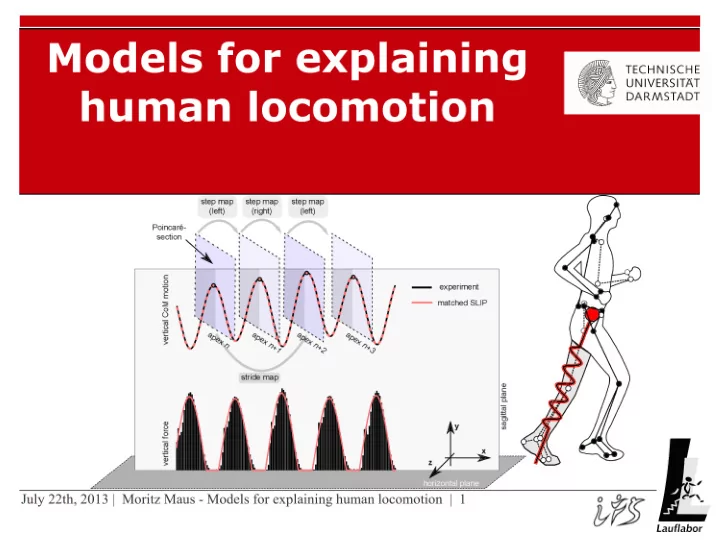

About Lauflabor ● Locomotion research since 2003 (Prof. Andre Seyfarth) ● Visit http://www.lauflabor.de
About me ● Moritz Maus ● Working in biomechanics since 2008 ● PhD in control engineering at TU Ilmenau 2012. Thesis: “Towards understanding human locomotion”
About this talk Topic is human running ● Introduction ● General characteristics of human treadmill running ● Linear model of “stationary” running ● Explicit mechanical models for locomotion (“templates”) ● Using templates to control robots ( overview)
Introduction
Why models? Everything you can calculate with is a model! – Multi-body simulation – Regression from experimental data – Models of atoms – Natural numbers: “model of the axioms” (logic)
A note on complexity ● Required level of complexity depends on the scientific question. ● More complex is not necessarily better – especially if you know little about the system. ● Example in bipedal robots: Who includes structural deformation of segments in the model?
Where do we stand? ● Comparison of robot and human performance ● → videos ● Robots can perform comparatively well ● Humans still by far outperform robots in terms of agility, adaptability, efficiency, robustness, …
Where do we stand?
Models used here Mainly two kind of models:
Human treadmill running characteristics
Data overview
Basic characteristics ● Stationarity? ● Possibly AR(1)-process? ( Floquet ↔ structure justified)
Investigating stationarity ● Procedure: – Re-sample data to 50 frames / stride – select 15 representative “coordinates” + corresponding velocities = 30 dim. – each stride is represented by 1500 numbers → stride is point in 1500-dim. “stride space” – perform PCA: → first axes cover most of information about a stride
Stationarity?
Summary of data ● Non-stationary, detrending required ● In lack of a better models, we nevertheless approximate the dynamics with a linear (Floquet) model around a limit cycle.
Floquet analysis Linear approximation to the dynamics around a hypothetical limit cycle
Eigenvalue analysis ● ● ● ● ● ●
Eigenvalues
Prediction analysis ● Goal: complementary stability analysis: “How long is the motion predictable?” (stable → short prediction (!) ) ● General linear model: x (ϕ)= A (ϕ , φ) x (φ)+η ● Predict state off limit cycle ● Compute relative remaining variance: var(state – prediction) / var(state) ● Bootstrap Out-of-sample prediction →
Prediction
Summary ● Linear models predict high stability, approximately 2-step deadbeat ● Explicitly: after 1 step, there is some variance that can be predicted!
Template models Explicit minimalistic mechanical models that reproduce human gait
Motivation ● Linear models: – don't tell us how the limit cycle is created – hardly tells us something about important features of the real system – don't give us a hint how to build mechanical analogon ● Idea: explicit mechanical gait models ● Requirement: similar behavior
About templates
SLIP model for running ● simple, intuitive, understandable model ● excellent match with experimental CoM dynamics ● complete step dynamics are reduced to a few model parameters ● How to gain insights with this model?
Example of a testable hypothesis
Control input identification
Autonomous system ● We compute maps: [CoM; Ankle] SLIP parameter → [CoM; Ankle] Ankle (n+1) → ● This + SLIP yield an autonomous system (9D apex map) ● Compare eigenvalues with 45-dim Floquet model
Comparison of eigenvalues
Summary (intermediate) ● Templates generate gaits (“reference” motion) ● SLIP is not self-contained w.r.t. capturing human running ● “SLIP + ankle” is (almost) an autonomous subsystem of human running at jogging speed ● However: not yet a full template: mechanical motion of ankles excluded!
Extending SLIP ● The bipedal SLIP is able to walk (Geyer, 2006) → video
What about the trunk?
The VPP model ● based upon bipedal walking SLIP
Summary: Templates ● Templates: highly reduced mechanical models ● Can describe human locomotion ● Can behave human-like: Useful for understanding human locomotion ● Simplicity allows generic investigations ● Attention: don't take too literally
Templates in robot control ( Overview only ) How templates can be used for robot control
Proof of concept ● “Mable” runs and walks using a SLIP-embedding controller → video Uses “hybrid zero dynamics” (Chevallereau et al., 2002; Poulakakis and Grizzle, 2009; ...)
Hybrid zero dynamics
Hybrid zero dynamics ● ●
Comparison
Thank you for your attention!
Recommend
More recommend